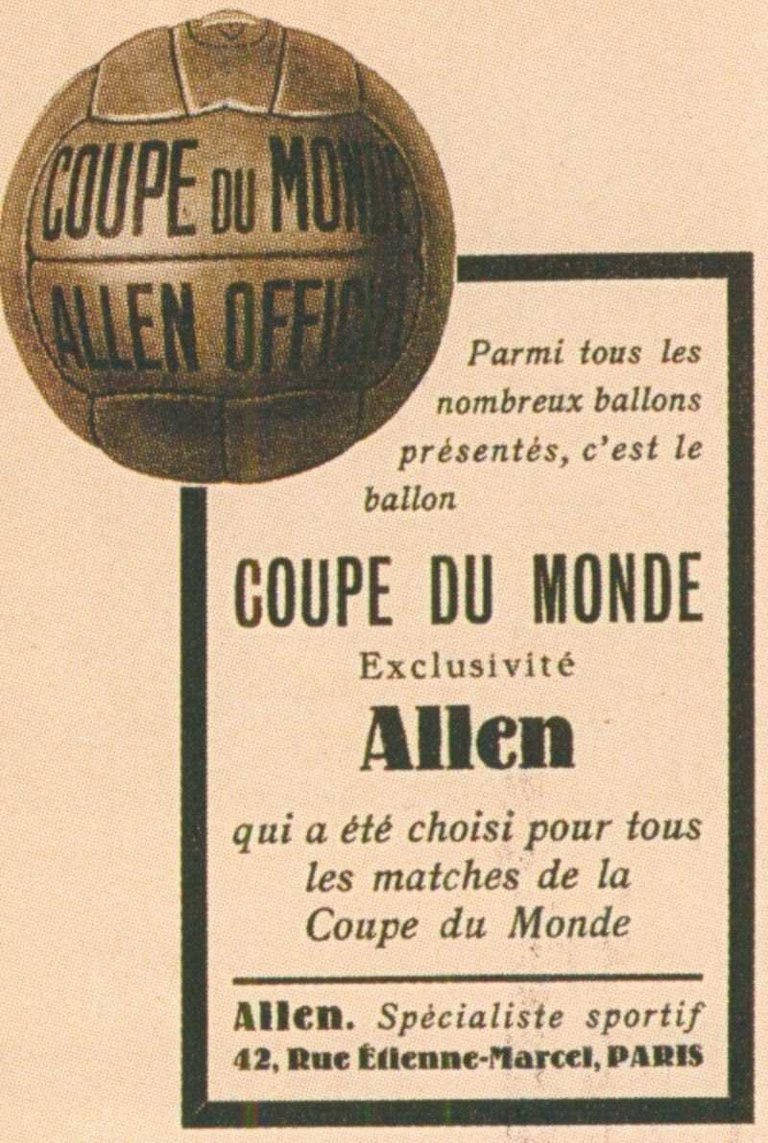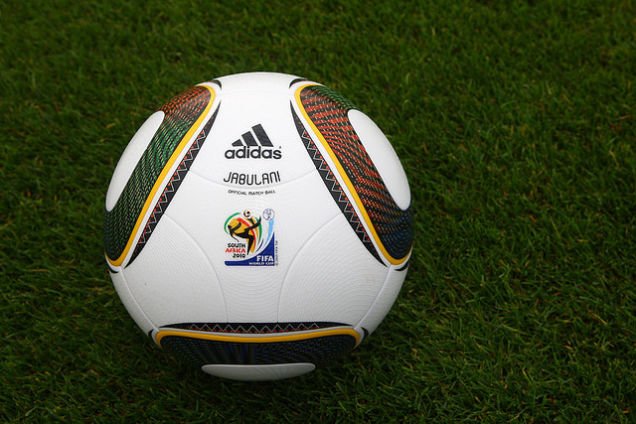
Every 4 years, the World Cup is played with a new ball. That makes it unique—after all, few other sports reinvent the wheel every four years.
The difference between the leather bladders of the 1930s and the high-performance materials of today are pretty stunning.
1930 World Cup in Uruguay
The very first World Cup used balls made in the country that was spreading the sport through the world: England. There were two types of laced balls used in the games, and the one you see below, the "T-Model," got its name from the distinctive t-shaped panel on its sides.
.jpg)
Image: World Cup Ball
The 1934 World Cup in Italy
By 1934, soccer was booming all over the world, and plenty of manufacturers in other countries were making balls, too. According to Pesti, the fevered nationalism of Mussolini-era Italy "required" that the balls used in their World Cup be made in Italy. Hence the Federale 102: a 13-panel lace-up ball made in Italy.

Image: World Cup Balls.
1938 World Cup in France
French World Cup, French soccer ball: The Paris-manufactured Allen, a 13-panel ball with laces—which were how these early balls were inflated, before the era of valves. It seems that other models were used in the matches, too, though there's no way to say how many.

Image: World Cup Balls.
1950 World Cup in Brazil
In the 1930s, an Argentinean company called Tossolini had made a breakthrough: A ball with a hidden valve that could be pumped into shape, rather than manually blown up through laces. But it took two decades for FIFA to accept the new design, and it wasn't until the 1950 World Cup that it saw play.

Image: World Cup Balls.
1954 World Cup in Switzerland
This Swiss-made ball was unique for its zig-zag edges, which were sewn together by hand, of course. The ball, like all official balls in those days, was completely free of printing and branding.

Image: World Cup Balls.
1958 World Cup in Sweden
This was the first year that FIFA selected its ball based on a competition. The winner in the randomized trial of more than 100 balls was a Swedish company called Sydsvenska Laderoch Remfabriken, who supplied a ball called Top Star notable for its waterproof waxed surface.

Image: World Cup Balls.
1962 World Cup in Chile
This ball was known as "the Crack." It was unique in the sense that its surface was composed of 18 irregular polygonal shapes, which gave it a complicated look. Here's the iconic Pelé kicking it around:

Image: World Cup Balls.
1966 World Cup in England
This ball, made by a British company of course, represents the end of an era: After 1966, Adidas took over the job of designing and manufacturing World Cup Balls. This baby was made of 25 rectangular panels and, notably, still adhered to the rule that there should be no markings or branding on the ball. Oh, how things have changed.

Image: World Cup Balls.
1970 World Cup in Mexico
And so came the era of Adidas, now a booming manufacturer of soccer-related items like shoots and balls. According to World Cup Balls, this ball was called the Telstar—a declension of "television" and "star," but it also could have been named for the Telstar satellite, which broadcast the World Cup all over the planet that year. It had 32 panels, like many contemporary balls, so it's easy to see it as the ur-ball for the present day sport.

Image: World Cup Balls.
1974 World Cup in Germany
For the 1974 World Cup, Adidas made small tweaks to its smash hit, the Telstar—including a more durable plastic coating that looks more like the super-slick soccer balls we know today. For night games, all-orange and all-white balls were made, too:
.jpg)
Image: Memora Football.
1978 World Cup in Argentina
This year, Adidas introduced a ball that World Cup Balls describes as "the most popular ball in the entire world:" The Tango. If you grew up in the 80s and 90s, this ball will look familiar to you: Though it was composed of the same 32 panels as its predecessor, Adidas' designers printed it with a unique triangular design that looked extremely cool in motion—hence its namesake, a dance.

Image: Balones Oficiales.
1982 World Cup in Spain
Again, the Tango was a huge success—and Adidas knew it. So for Spain four years later, it kept the ball largely the same. Except for one exception: A new polyurethane coating, which made it far, far less likely to absorb water.

Image: Balones Oficiales.
1986 World Cup in Mexico
Given the fact that the ball design itself wasn't changing much, Adidas introduced a new novelty: A printed design based on the culture of the host country—in this case, Aztec symbology.

Image: World Cup Balls.
1990 World Cup in Italy
Another host country, another regional makeover, this one for Italy—this ball was called the Etrusco Unico.

Image: World Cup Balls.
1994 World Cup in the USA
Here was where Adidas' tradition started to wear thin: The Adidas Questra, the ball used in the US's first World Cup, was decorated with stars and constellations. Adidas' reasoning? 1994 was the 25th anniversary of the Apollo 11 mission.

Image: World Cup Balls.
1998 World Cup in France
And then there was the Tricolore—another version of the classic 1978 Tango design, again decorated with the host country's national colors. But there are a few notable technical changes here: This was the first World Cup ball to use multiple colors, whereas before, single colors were deemed easier to see on the pitch. It was also the first ball to be manufactured outside of Europe. Finally, it was the last Tango we'd see in the World Cup. After this, a new era of high-performance design was upon us.

Image: World Cup Balls.
2002 World Cup in South Korea/Japan
The Adidas Fevernova sported an Asia-inspired look, according to Adidas, as well as some major technical changes—including the addition of some high-performance interior materials like syntactic foam, a type of composite that is filled with hollow "balloons" to decrease weight. As a result, many critics said made it too light—some goalies even claimed it cost them goals.

Image: World Cup Balls.
The 2006 World Cup in Germany
The Teamgeist, as this official ball was known, incorporated a brand-new 14-panel design and a major technological breakthrough: Its seams were heat sealed, rather than sewn. That means this ball is completely waterproof—a first for more than a century of balls.

Image: World Cup Balls.
2010 World Cup in South Africa
The Jabulani was one of the most-hated balls of all time. With eight panels and a patterned surface that was said to improve its aerodynamics, it was supposed to build on the success of its predecessor. Instead, players were bitingly critical, saying it was unpredictable, a "shameful" "disaster," comparing it to a cheap ball you'd find at a supermarket.

Image: adifansnet.
2014 World Cup in Brazil
The Brazuca. This ball has only six panels, and it's decorated with an interlocking swooping pattern that's completely unique.

Image:
Thanks for going through this post, for more posts like this follow me, also do well to upvote, comment on this post and resteem this post if you find it useful.

Hi! I am a robot. I just upvoted you! I found similar content that readers might be interested in:
https://gizmodo.com/a-brief-history-of-every-official-world-cup-ball-since-1591285816